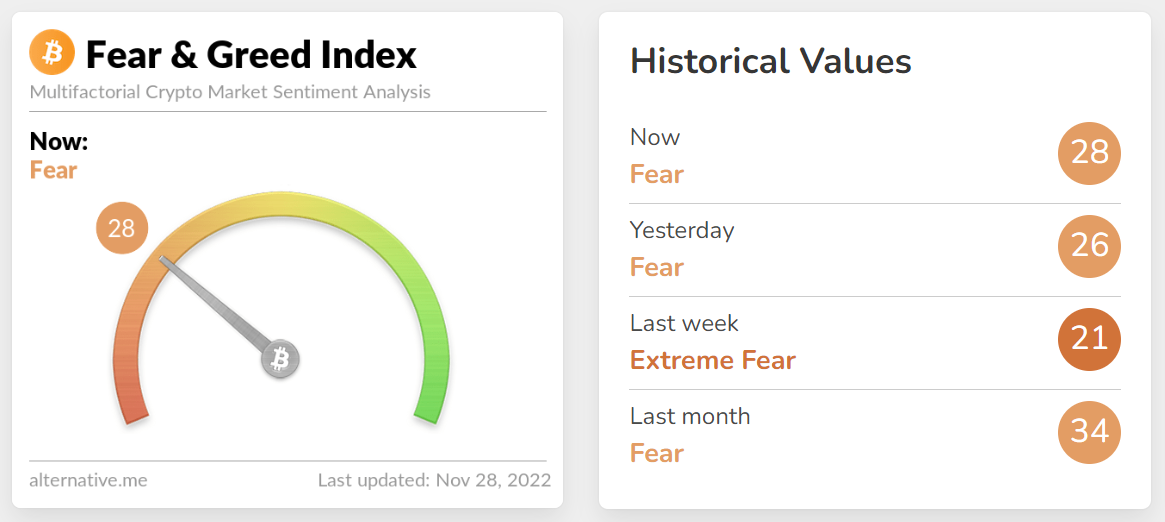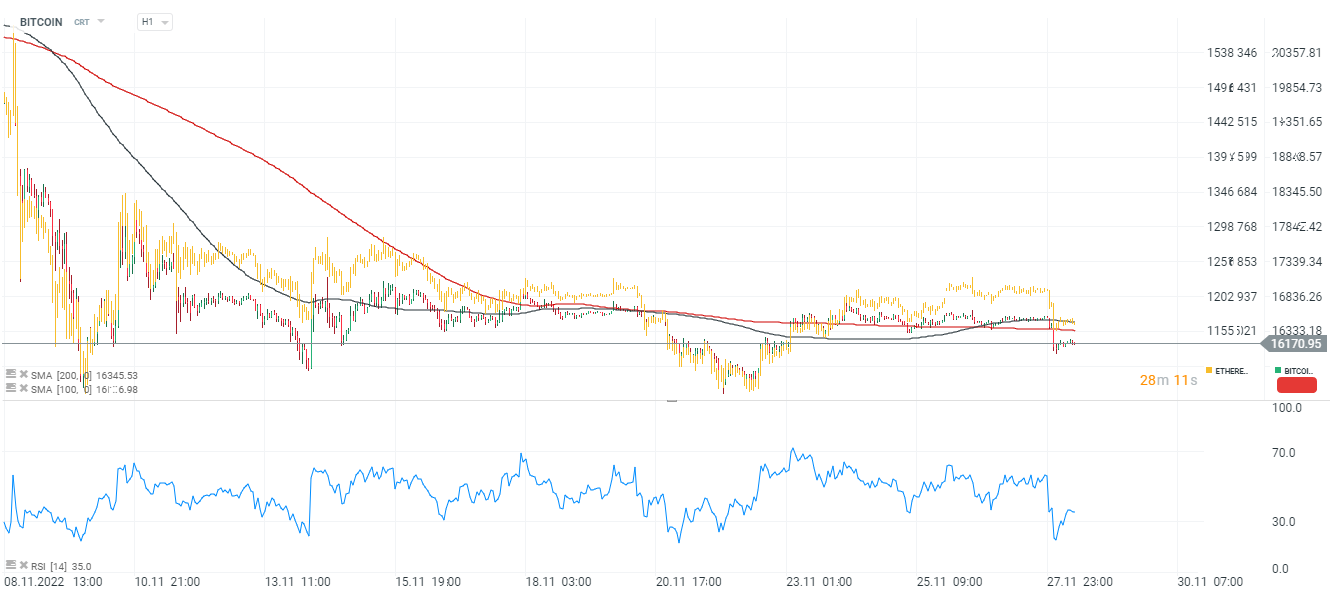Cryptocurrencies have come under pressure amid stress in the Bitcoin miner market, and Ethereum has retreated amid reports of record cryptocurrency inflows to centralized exchanges from where whales may want to distribute:
Bitcoin's price has fallen below $16,300 again. Ethereum is trading below the psychological limit of $1,200.
Start investing today or test a free demo
Create account Try a demo Download mobile app Download mobile app- Ether lost after the whale moved 73,224 ETH on the Binance exchange, the value of the transaction was more than $85 million. Looknonchain analysts warned the market of possible entrenched supply pressure on Ethereum. Investors typically move reserves onto from private portfolios to exchanges when they intend to sell or use reserves as collateral in derivatives trading. The influx likely heralds impending volatility. The same ETH holder last week pulled 84,131 ETH from the Curve exchange's liquidity pool, then for a while the price of the stETH token dropped to 0.97 and lost its 1:1 ratio to ETH, since then it has still struggled to reach parity;
- Controversy swept the market over 'wETH' tokens, which were said to lack 1:1 Ether coverage. Analysts dismantled them, stressing that wETH is secured by a smart contract that has no visible flaws in the code that could indicate a lack of security. The so-called 'wrapped ETH' is a version of ETH that aims to allow ERC-20 tokens (built in the Ethereum ecosystem) to be exchanged more easily, and was introduced because ERC-20 tokens built on the network cannot be traded via ETH. The controversy quickly shifted to theBTC that Alameda held - in the amount of 100,000. Chances are that they were not backed by 100,000 BTC and defacto were created 'out of thin air' - the November 11 bankruptcy document did not indicate any BTC in the exchange's reserves. This fact was pointed out by Matrixport analysts, among others;
- The AAX cryptocurrency exchange is still not processing withdrawals. Its vice president of global marketing and communications Ben Caselin announced that he has resigned from his role . Caselin described the exchange's actions as "lacking empathy" and "non-transparent." According to Caselin, despite his efforts, the initiatives he came out with were not accepted. The exchange was one of the first entities to suspend payments after the FTX collapse.
Cryptocurrencies in the US Congress
Back in the summer, Senator Cynthia Lummis teamed up with New York Democrat Kirsten Gillibrand to create the Responsible Financial Innovation Act, which promised a "complete regulatory framework for digital assets." The bill seeks to delineate the differences between securities and commodities, giving the Commodity Futures Trading Commission (CFTC) more authority to regulate cryptocurrencies. It would also establish an advisory committee to help lawmakers and regulators streamline the evolving world of virtual currencies and services. Still on the table, however.
- "The industry wants regulation because they want to be able to separate the wheat from the chaff (...) They want to make sure that those who are dishonest can't participate in the market." - Kirsten Gillibrand commented on the latest cryptocurrency market news
- "I think many members of Congress have assumed that the digital asset industry can lie on the sidelines because it is immature (...) It is growing faster than people recognize it. And now that Elon Musk has announced that he may use Twitter as a payment platform.... I mean this industry is much more mature than people think. The time has come. It's time for regulation (...) There will still be companies trading digital assets, which may go under even after regulation.... But at least we'll have consumer protection and reporting - and the most important thing is to separate customer assets from those of the financial institution (...) What happened with FTX is that it lent out customer assets." - According to Cynthia Lummis, a Republican from Wyoming, the rise of cryptocurrencies and the dangers that come with them took Congress itself by surprise.
After the collapse of FTX, digital assets have become a topic frequently discussed by other members of Congress as well, but not all of them prioritize the issue, sometimes even responding that the topic is outside their current area of interest:
"It's not really an issue that I know quite a bit about" - said Bernie Sanders, an independent US senator from Vermont
"I don't really understand the technology." - commented on the latest industry news, US Senator Josh Hawley, a Republican from Missouri.
"Well, I think it's an issue that I guess will be taken up by the Financial Services Committee (...) There's a whole bunch of issues that I think we plan to work through, and I can imagine that the cryptocurrency industry situation will be one of them moving forward" - replied Hakeem Jeffries, a Democrat from New York, when asked about addressing the volatility and regulation of cryptocurrencies Bitcoin miners are experiencing tremendous stress in the face of a deteriorating environment for doing business. Looking at the main metric known as 'Hash Ribbons', we can assume that some of them are preparing for a massive Bitcoin sell-off that could have a "capitulation" effect if there are not enough buyers on the other side. The indicator uses two moving averages of 30 and 60 days (blue and purple lines, respectively). Their intersections mark the capitulation or recovery phases, when miners start accumulating again. In this case, however, we are approaching the former when the 30-day average intersects the 60-day average. Previously, this intersection preceded a drop from $35,000 to $20,000. Costs are getting higher due to, among other things, the increasing computing power of the BTC network and electricity prices, and doing business when bitcoin is at record lows becomes even more difficult. Source: lookintobitcoin
Bitcoin miners are experiencing tremendous stress in the face of a deteriorating environment for doing business. Looking at the main metric known as 'Hash Ribbons', we can assume that some of them are preparing for a massive Bitcoin sell-off that could have a "capitulation" effect if there are not enough buyers on the other side. The indicator uses two moving averages of 30 and 60 days (blue and purple lines, respectively). Their intersections mark the capitulation or recovery phases, when miners start accumulating again. In this case, however, we are approaching the former when the 30-day average intersects the 60-day average. Previously, this intersection preceded a drop from $35,000 to $20,000. Costs are getting higher due to, among other things, the increasing computing power of the BTC network and electricity prices, and doing business when bitcoin is at record lows becomes even more difficult. Source: lookintobitcoin The on-chain MVRV metric divides Bitcoin's current capitalization by its realized capitalization (at the average blockchain purchase price). Historically, the ratio has worked well as a measure of extremes used to assess the likelihood of a 'price bottom'. Despite the huge scale of scandals and market uncertainty, the major cryptocurrency still behaves in many ways similar to previous bear markets. The indicator has twice this year knocked out levels close to the bottom of previous cycles indicating a record gap between the average price of Bitcoin purchased and the current price. This means that, as in previous down cycles, the vast majority of the market is drowning in losses. The major cryptocurrency is, of course, similarly to previous cycles, trading below the 200-session average below which it has been for almost 250 days. Historically, this period ended with a sharp rebound. Source: WillyWoo, Cointelegraph
The on-chain MVRV metric divides Bitcoin's current capitalization by its realized capitalization (at the average blockchain purchase price). Historically, the ratio has worked well as a measure of extremes used to assess the likelihood of a 'price bottom'. Despite the huge scale of scandals and market uncertainty, the major cryptocurrency still behaves in many ways similar to previous bear markets. The indicator has twice this year knocked out levels close to the bottom of previous cycles indicating a record gap between the average price of Bitcoin purchased and the current price. This means that, as in previous down cycles, the vast majority of the market is drowning in losses. The major cryptocurrency is, of course, similarly to previous cycles, trading below the 200-session average below which it has been for almost 250 days. Historically, this period ended with a sharp rebound. Source: WillyWoo, Cointelegraph The Fear and Greed Index of the cryptocurrency market indicates a level of 28 points, which corresponds to levels between 'Fear' and 'Extreme Fear'. However, the situation has not changed to much better than the previous week. This could herald that the market could easily return to extreme pessimistic sentiment if Bitcoin returns to the area below $16,000. Source: alternative.me
The Fear and Greed Index of the cryptocurrency market indicates a level of 28 points, which corresponds to levels between 'Fear' and 'Extreme Fear'. However, the situation has not changed to much better than the previous week. This could herald that the market could easily return to extreme pessimistic sentiment if Bitcoin returns to the area below $16,000. Source: alternative.me Bitcoin's historical monthly returns on a monthly basis. Source: cointelegraph
Bitcoin's historical monthly returns on a monthly basis. Source: cointelegraph Bitcoin chart, H1 interval. The major cryptocurrency moves with almost the same volatility as Ethereum (yellow). The current decline below the 100 (black) and 200-day moving average (red) raises concerns of a longer capitulation and continued pressure to look for a bottom below annual lows. Source: xStation5
Bitcoin chart, H1 interval. The major cryptocurrency moves with almost the same volatility as Ethereum (yellow). The current decline below the 100 (black) and 200-day moving average (red) raises concerns of a longer capitulation and continued pressure to look for a bottom below annual lows. Source: xStation5
This content has been created by XTB S.A. This service is provided by XTB S.A., with its registered office in Warsaw, at Prosta 67, 00-838 Warsaw, Poland, entered in the register of entrepreneurs of the National Court Register (Krajowy Rejestr Sądowy) conducted by District Court for the Capital City of Warsaw, XII Commercial Division of the National Court Register under KRS number 0000217580, REGON number 015803782 and Tax Identification Number (NIP) 527-24-43-955, with the fully paid up share capital in the amount of PLN 5.869.181,75. XTB S.A. conducts brokerage activities on the basis of the license granted by Polish Securities and Exchange Commission on 8th November 2005 No. DDM-M-4021-57-1/2005 and is supervised by Polish Supervision Authority.

